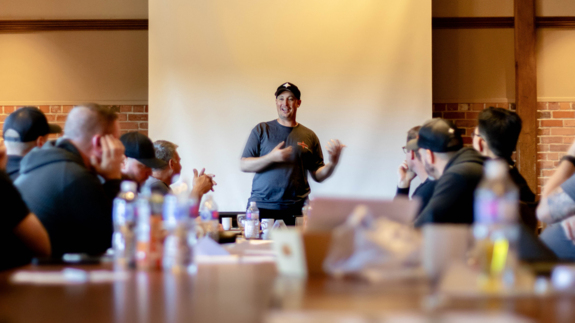How this electrical contractor tripled revenue in 6 years

When he took over from the retiring founder in 2018, Aaron Jones already had some 15 years of experience working at the Niagara Region-based electrical company. After rising through the ranks and earning a business degree, he was ready to take it to the next level.
Demand took off under the new management team. But it didn’t take long for Aaron and his business partner Kelly Braun to run into the kind of challenges that come with quick success.
“I was doing a lot of the work. Kelly was doing a lot of the work, and we realized that we needed to share that workload, or we weren’t going to be able to grow well,” Aaron recalls.
What positions they needed to create and fill was one of the questions they asked BDC Advisory Services, who helped them create their strategic plan. In the process, they also reflected on whether to expand into new markets.
“We were able to just put some boundaries around the different services that we offered and define them a little bit better for the customers,” he says. “Internally, we were able to align our employees much better in terms of the different services.”
With an expertise that spans the residential, commercial and industrial markets, Kraun Electric takes on a broad range of contracts, from replacing a ceiling fan to designing and building the electrical system of a multimillion project. Under new management, staff has doubled to more than 100 people.
The freshly minted three-year plan gave the company a clear direction and a set of changes to implement at the onset of the pandemic, preparing it well for the surge in demand that followed. But there was something else that allowed them to grow rapidly: new technology.
Picking the best software
“We had a few different systems. They didn’t feel like the right systems for our new reality,” says Aaron. “Sometimes we found ourselves using software that was better used in one area of the business, but because we had it, we were going to try and force the square peg into a round hole.”
Working with BDC technology experts, the company decided to adopt best-in-class software for each area of its business and integrate the different systems. It uses one product for day-to-day office work, another to manage sales efforts, and a third for its services operations. In addition, project managers and supervisors work in the field with construction-specific software.
Such a strategy requires some flexibility. Since it is too small for custom-made systems, the company has had to adjust its internal processes to the software, rather than the other way around. But Aaron noticed employees have warmed up to it.
“A lot of our staff that were initially a little bit nervous about it are actually champions of the software now and say it’s made their life a lot better,” he says.

Keeping an eye out for AI
In a very competitive market, technology has helped the company adjust its pricing by analyzing the costs of thousands of electrical components. Its software also harnesses artificial intelligence to suggest which employee should be dispatched for a given job to minimize driving time and best meet customers’ requirements.
One of Aaron’s longer-term projects is to mine data from the different software systems to glean additional insights.
A 2024 BDC study revealed that most small and medium-sized enterprises already use some AI-powered tools, though many don’t realize it. Almost half of business owners said they plan to use more AI within the next 24 months.
Ultimately, the technology is bound to impact the construction industry more directly, Aaron predicts.
“We will eventually start to see those technologies trickle out to the field, whether it’s through surveying equipment or laying out of construction work or even, at some point in the future, using some really advanced tools or robotics out in the construction market,” he says. “We haven’t seen a ton of that yet, but we’re definitely keeping our eye out for it.”
Getting the culture right
At a time when the construction industry struggles with labour shortages, Aaron says recruitment hasn’t been much of a concern.
“We have been very successful at getting the electricians that we need, and for us, the No.1 reason has been our relentless focus on our culture and our brand,” he says. “We give them a great place just to do their craft.”
The company has put a lot of effort into training. It encourages strong relationships between coworkers and has committed to a high level of service, both to customers and between employees. And it has made professional growth a key part of its culture.
I started here as a laborer, some 20-odd years ago, and worked my way up to the position I’m in now. So, there’s lots of growth in the company.
Aaron Jones
President and CEO, Kraun Electric
Aaron’s own journey is the best advertising for it: His very first job at Kraun Electric was taking the boss’s lawn mower to the repair shop. He became an electrician and a site supervisor before falling in love with the business side of things.
In the six years Aaron and Kelly have run the company, revenue has nearly tripled, creating opportunities for employees to try out different divisions and take on new responsibilities.
“I started here as a laborer, some 20-odd years ago, and worked my way up to the position I’m in now, he says. “So, there’s lots of growth in the company.”

Don’t try to do it alone
Entrepreneurs are used to overcoming obstacles on their own, but they shouldn’t hesitate to seek outside expertise, especially on technology, says the CEO.
“You’re going to get there a lot faster if you get help, and you’re going to avoid a lot of mistakes,” he says.
Still, change is going to generate some pushback, and business owners need to listen to their staff’s concerns and explain how the new tools will make the teams more successful, Aaron says.
“It’s really important that you help your employees feel safe during those transitions, because at the end of the day, they’re the ones who are going to use it and they’re the ones that will make or break that return on investment.”
Next step
Discover how to develop a digital strategy for your business and invest in the right technology to improve efficiency and customer experience with this free guide for entrepreneurs Making Tech Work for Your Business.